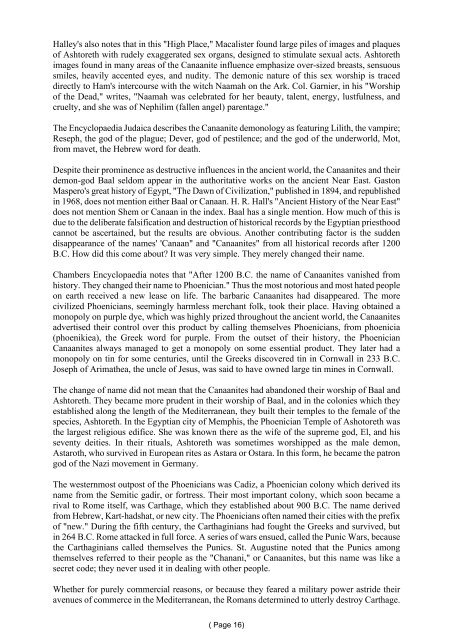Curse of Cannan - The New Ensign
Curse of Cannan - The New Ensign
Curse of Cannan - The New Ensign
Create successful ePaper yourself
Turn your PDF publications into a flip-book with our unique Google optimized e-Paper software.
Halley's also notes that in this "High Place," Macalister found large piles <strong>of</strong> images and plaques<br />
<strong>of</strong> Ashtoreth with rudely exaggerated sex organs, designed to stimulate sexual acts. Ashtoreth<br />
images found in many areas <strong>of</strong> the Canaanite influence emphasize over-sized breasts, sensuous<br />
smiles, heavily accented eyes, and nudity. <strong>The</strong> demonic nature <strong>of</strong> this sex worship is traced<br />
directly to Ham's intercourse with the witch Naamah on the Ark. Col. Garnier, in his "Worship<br />
<strong>of</strong> the Dead," writes, "Naamah was celebrated for her beauty, talent, energy, lustfulness, and<br />
cruelty, and she was <strong>of</strong> Nephilim (fallen angel) parentage."<br />
<strong>The</strong> Encyclopaedia Judaica describes the Canaanite demonology as featuring Lilith, the vampire;<br />
Reseph, the god <strong>of</strong> the plague; Dever, god <strong>of</strong> pestilence; and the god <strong>of</strong> the underworld, Mot,<br />
from mavet, the Hebrew word for death.<br />
Despite their prominence as destructive influences in the ancient world, the Canaanites and their<br />
demon-god Baal seldom appear in the authoritative works on the ancient Near East. Gaston<br />
Maspero's great history <strong>of</strong> Egypt, "<strong>The</strong> Dawn <strong>of</strong> Civilization," published in 1894, and republished<br />
in 1968, does not mention either Baal or Canaan. H. R. Hall's "Ancient History <strong>of</strong> the Near East"<br />
does not mention Shem or Canaan in the index. Baal has a single mention. How much <strong>of</strong> this is<br />
due to the deliberate falsification and destruction <strong>of</strong> historical records by the Egyptian priesthood<br />
cannot be ascertained, but the results are obvious. Another contributing factor is the sudden<br />
disappearance <strong>of</strong> the names' 'Canaan" and "Canaanites" from all historical records after 1200<br />
B.C. How did this come about? It was very simple. <strong>The</strong>y merely changed their name.<br />
Chambers Encyclopaedia notes that "After 1200 B.C. the name <strong>of</strong> Canaanites vanished from<br />
history. <strong>The</strong>y changed their name to Phoenician." Thus the most notorious and most hated people<br />
on earth received a new lease on life. <strong>The</strong> barbaric Canaanites had disappeared. <strong>The</strong> more<br />
civilized Phoenicians, seemingly harmless merchant folk, took their place. Having obtained a<br />
monopoly on purple dye, which was highly prized throughout the ancient world, the Canaanites<br />
advertised their control over this product by calling themselves Phoenicians, from phoenicia<br />
(phoenikiea), the Greek word for purple. From the outset <strong>of</strong> their history, the Phoenician<br />
Canaanites always managed to get a monopoly on some essential product. <strong>The</strong>y later had a<br />
monopoly on tin for some centuries, until the Greeks discovered tin in Cornwall in 233 B.C.<br />
Joseph <strong>of</strong> Arimathea, the uncle <strong>of</strong> Jesus, was said to have owned large tin mines in Cornwall.<br />
<strong>The</strong> change <strong>of</strong> name did not mean that the Canaanites had abandoned their worship <strong>of</strong> Baal and<br />
Ashtoreth. <strong>The</strong>y became more prudent in their worship <strong>of</strong> Baal, and in the colonies which they<br />
established along the length <strong>of</strong> the Mediterranean, they built their temples to the female <strong>of</strong> the<br />
species, Ashtoreth. In the Egyptian city <strong>of</strong> Memphis, the Phoenician Temple <strong>of</strong> Ashotoreth was<br />
the largest religious edifice. She was known there as the wife <strong>of</strong> the supreme god, El, and his<br />
seventy deities. In their rituals, Ashtoreth was sometimes worshipped as the male demon,<br />
Astaroth, who survived in European rites as Astara or Ostara. In this form, he became the patron<br />
god <strong>of</strong> the Nazi movement in Germany.<br />
<strong>The</strong> westernmost outpost <strong>of</strong> the Phoenicians was Cadiz, a Phoenician colony which derived its<br />
name from the Semitic gadir, or fortress. <strong>The</strong>ir most important colony, which soon became a<br />
rival to Rome itself, was Carthage, which they established about 900 B.C. <strong>The</strong> name derived<br />
from Hebrew, Kart-hadshat, or new city. <strong>The</strong> Phoenicians <strong>of</strong>ten named their cities with the prefix<br />
<strong>of</strong> "new." During the fifth century, the Carthaginians had fought the Greeks and survived, but<br />
in 264 B.C. Rome attacked in full force. A series <strong>of</strong> wars ensued, called the Punic Wars, because<br />
the Carthaginians called themselves the Punics. St. Augustine noted that the Punics among<br />
themselves referred to their people as the "Chanani," or Canaanites, but this name was like a<br />
secret code; they never used it in dealing with other people.<br />
Whether for purely commercial reasons, or because they feared a military power astride their<br />
avenues <strong>of</strong> commerce in the Mediterranean, the Romans determined to utterly destroy Carthage.<br />
( Page 16)
















